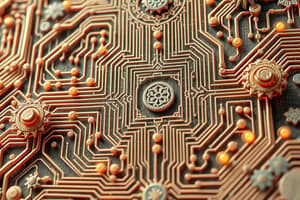Podcast
Questions and Answers
Which of the following is NOT a key component of VLSI design?
Which of the following is NOT a key component of VLSI design?
- Transistors
- Software Algorithms (correct)
- Packages
- Interconnects
Which of the following design methodologies is NOT part of the VLSI Design Flow?
Which of the following design methodologies is NOT part of the VLSI Design Flow?
- Algorithmic Design (correct)
- Architectural Design
- Specification
- Logic Design
What is the primary concern addressed during the "Layout Design" stage of VLSI?
What is the primary concern addressed during the "Layout Design" stage of VLSI?
- Creating the specific logic equations for transistors
- Organizing the overall structure of the chip
- Transforming logic into a physical representation with considerations for dimensions, interconnects, and power consumption (correct)
- Defining the functionality of the circuit
Which of the following is NOT a significant challenge faced by VLSI designers?
Which of the following is NOT a significant challenge faced by VLSI designers?
In the context of VLSI design, what is the primary function of interconnects?
In the context of VLSI design, what is the primary function of interconnects?
Which of the following best describes the purpose of 'Verification' in the VLSI Design Flow?
Which of the following best describes the purpose of 'Verification' in the VLSI Design Flow?
What is the significance of the 'Physical Design' stage in the VLSI Design Flow?
What is the significance of the 'Physical Design' stage in the VLSI Design Flow?
Which of these is NOT a common design challenge related to scaling in VLSI designs?
Which of these is NOT a common design challenge related to scaling in VLSI designs?
Which of the following VLSI technologies primarily contributes to the miniaturization of chips, allowing for increased transistor density and improved performance?
Which of the following VLSI technologies primarily contributes to the miniaturization of chips, allowing for increased transistor density and improved performance?
What is the main challenge associated with design verification in VLSI?
What is the main challenge associated with design verification in VLSI?
Which of the following scenarios exemplifies the trade-off between custom design and standard cells in VLSI?
Which of the following scenarios exemplifies the trade-off between custom design and standard cells in VLSI?
What is the primary advantage of using a System-on-a-Chip (SoC) approach in VLSI design?
What is the primary advantage of using a System-on-a-Chip (SoC) approach in VLSI design?
How does the design verification process for an SoC differ from the verification of a simpler chip?
How does the design verification process for an SoC differ from the verification of a simpler chip?
Based on Moore's Law, what is the anticipated trend for the feature sizes of transistors in the future?
Based on Moore's Law, what is the anticipated trend for the feature sizes of transistors in the future?
Which of the following factors is NOT directly related to the chip yield in VLSI manufacturing?
Which of the following factors is NOT directly related to the chip yield in VLSI manufacturing?
How do the design advancements in VLSI relate to the increasing trend of high-performance computing (HPC)?
How do the design advancements in VLSI relate to the increasing trend of high-performance computing (HPC)?
Flashcards
VLSI
VLSI
Very Large Scale Integration for creating complex ICs.
Transistors
Transistors
Building blocks that control current flow in circuits.
Interconnects
Interconnects
Links between transistors that transmit signals within a chip.
Logic Blocks
Logic Blocks
Signup and view all the flashcards
Design Flow
Design Flow
Signup and view all the flashcards
Power Consumption
Power Consumption
Signup and view all the flashcards
Verification
Verification
Signup and view all the flashcards
Scaling Challenges
Scaling Challenges
Signup and view all the flashcards
Manufacturing
Manufacturing
Signup and view all the flashcards
Design Verification
Design Verification
Signup and view all the flashcards
Microprocessors
Microprocessors
Signup and view all the flashcards
CMOS
CMOS
Signup and view all the flashcards
FinFET
FinFET
Signup and view all the flashcards
System-on-a-Chip (SoC)
System-on-a-Chip (SoC)
Signup and view all the flashcards
Moore's Law
Moore's Law
Signup and view all the flashcards
AI/ML Acceleration
AI/ML Acceleration
Signup and view all the flashcards
Study Notes
Introduction to VLSI
- VLSI (Very Large Scale Integration) is a process of creating integrated circuits (ICs) with a very large number of transistors on a single chip.
- This leads to smaller, faster, more powerful, and less expensive electronics.
- The intricate nature of VLSI designs often surpasses human comprehension of the entire design.
- Various design methodologies and tools facilitate the creation of VLSI systems.
Key Components of VLSI Design
- Transistors: Fundamental building blocks controlling current flow. Different types (MOSFETs being common) determine circuit function.
- Interconnects: Links between transistors, enabling signal transmission and communication within the chip. Their cross-section area is crucial for signal integrity.
- Circuits/Logic Blocks: Groups of transistors arranged to perform specific logical operations (e.g., add, multiply, compare).
- Packages: Physical enclosures protecting the IC chip, providing support, and connections to external circuits.
- Design Software Tools: Essential for designing, simulating, and verifying VLSI circuits (e.g., Cadence, Synopsys).
VLSI Design Flow
- Specification: Defines the intended functionality of the VLSI design.
- Architectural Design: Defines the overall structure and organization of the chip.
- Logic Design: Creates detailed logic equations specifying how transistors execute operations.
- Layout Design: Transforms the logic design into a physical layout, considering factors like transistor dimensions, interconnects, and power/ground routing.
- Physical Design: The complete implementation into a physical image.
- Verification: Ensures functionality as intended. Verification steps occur at various stages, crucial for error prevention.
- Implementation: The physical creation of the chip.
VLSI Design Challenges
- Complexity: Managing the multitude of components and interconnections is difficult.
- Scaling: Maintaining performance and power consumption becomes increasingly challenging with shrinking features.
- Power Consumption: Power dissipation is a critical constraint, especially in portable applications. Minimizing power consumption is essential.
- Manufacturing: Sophisticated fabrication techniques are needed to create chips with minuscule features. Chip yield is also crucial for profitability.
- Design Verification: Accurate verification, especially for intricate systems, necessitates substantial testing. Proper verification is vital to producing quality products.
VLSI Applications
- Microprocessors: The computational brains of computers.
- Memory Chips: Store data in computers.
- Communication Systems: Enable data transfer and communication.
- Embedded Systems: Control specific devices or machines (e.g., automotive/sensor systems).
- Image/Audio Processing: Used for processing and enhancing images and audio signals.
- Digital Signal Processing (DSP): Employed in audio/video, cellular communication, and more.
VLSI Technologies
- CMOS (Complementary Metal-Oxide-Semiconductor): The predominant fabrication technology, offering excellent power efficiency and affordability.
- FinFET: Advanced transistor structure with fin-like shapes for superior performance and power efficiency with reduced sizes.
- 3D Integration: Stacking multiple chips vertically to increase chip density and performance.
- Advanced Packaging: Enhancing IC packaging to improve performance, reduce size, and accommodate modern system demands.
VLSI Trends
- Moore's Law: Continued trends toward smaller feature sizes and increased transistor counts, although adherence to the law isn't as strict.
- Custom Design vs. Standard Cells: A trade-off exists between customized designs optimizing functionality and standard cells maximizing fabrication speed. Often a blend of both is used.
- System-on-a-Chip (SoC): Integrating multiple processing units, memories, and peripherals onto a single chip.
- High-performance computing (HPC): Design advancements optimize processing speed in highly parallel architectures.
- AI/ML acceleration: Increasingly specialized hardware for artificial intelligence and machine learning computations.
Studying That Suits You
Use AI to generate personalized quizzes and flashcards to suit your learning preferences.



